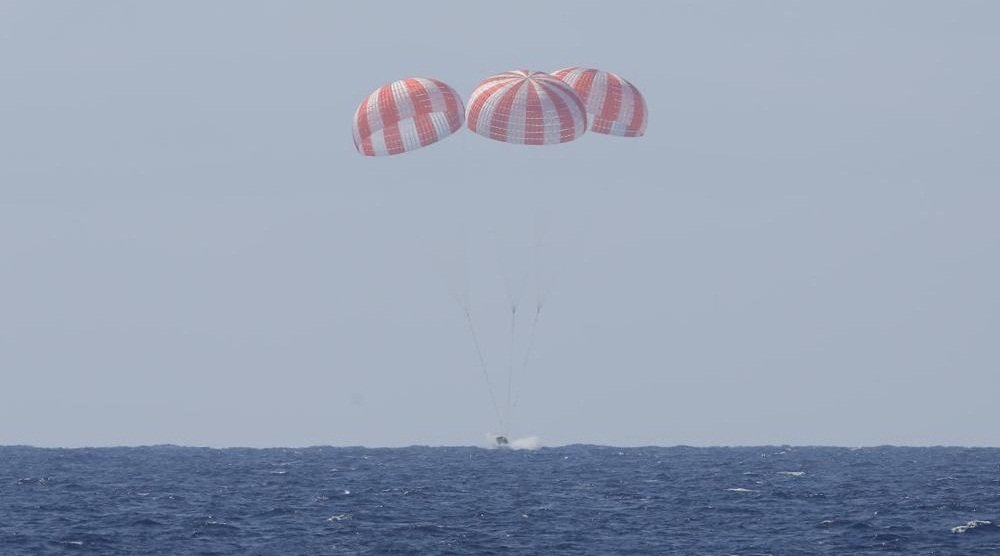
The last month has seen spectacular success for SpaceX, as the Hawthorne, Calif.-based launch services provider flawlessly conducted a pair of missions to Low-Earth Orbit (LEO) and Geostationary Transfer Orbit (GTO) and brought a pair of Upgraded Falcon 9 first stages back through the furnace heat of re-entry to safely land on the Autonomous Spaceport Drone Ship (ASDS) in the Atlantic Ocean. And the last month has also seen SpaceX resume operations of its Dragon cargo ship to the International Space Station (ISS) after a year-long hiatus.
At 9:19 a.m. EDT Wednesday, the CRS-8 Dragon—the eighth dedicated cargo mission flown under the initial $1.6 billion Commercial Resupply Services contract between NASA and SpaceX—was detached from the orbital outpost to head back to Earth. At 2:54 p.m. EDT (11:54 a.m. PDT), it parachuted into the waters of the Eastern Pacific Ocean, bearing around 3,700 pounds (1,700 kg) of hardware and experiment samples. The successful splashdown brought to an end the third-longest Dragon mission to date. In total, CRS-8 spent 32 days, 22 hours, and 11 minutes in flight. This is slightly eclipsed by the 34.5-day mission of CRS-4 in the fall of 2014 and the 37-day voyage of last year’s CRS-6.
Preparatory work for the CRS-8 departure got underway several days ago, when Dragon was robotically grappled by the 57.7-foot-long (17.6-meter) Canadarm2 robotic arm. The so-called “Big Arm”—installed onto the station 15 years ago by the STS-100 shuttle crew—was commanded by the Robotics Officer (ROBO) in the Mission Control Center (MCC) at the Johnson Space Center (JSC) in Houston, Texas. Earlier this week, the Expedition 47 U.S. Orbital Segment (USOS) team of Commander Tim Kopra and Flight Engineers Jeff Williams and Britain’s Tim Peake spent time reviewing Dragon departure procedures and training to release the cargo ship from Canadarm2.
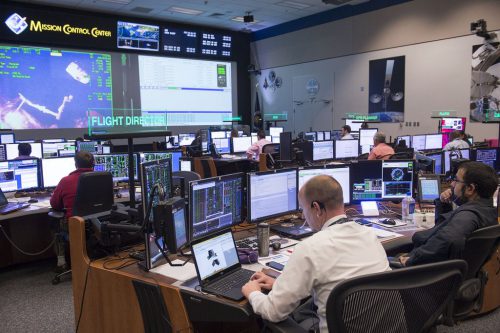
Having served in the prime role for the CRS-8 capture and berthing on 10 April, Peake also led the effort to bid farewell to Dragon, as it began its journey back to Earth. Stationed in the multi-windowed cupola, Peake was backed-up by Williams, whilst Kopra oversaw Common Berthing Mechanism (CBM) operations at the vestibule interface between Dragon and the Harmony node.
Overseeing today’s departure from Mission Control was Flight Director Amit Kshatriya, with NASA astronaut Serena Aunon seated at the Capcom’s console and Billy Jones at the ROBO console. However, Mr. Jones’ role in unberthing and moving Dragon to its release position was a shared responsibility with the Canadian Space Agency (CSA). Meanwhile, in Hawthorne, Calif., a team headed by Lead Dragon Mission Director Paul Tompkins oversaw the departure and re-entry from the SpaceX Mission Control Center.
For the first time, a Dragon was being unberthed whilst another U.S. cargo ship—Orbital ATK’s OA-6 Cygnus—was also in residence at the USOS. Due to the relatively close proximity of the two vehicles, with Cygnus at the Earth-facing (or “nadir”) interface of the Unity node and Dragon at the nadir interface of the adjacent Harmony node, this called for a change to the unberthing and pre-release positioning of the departing cargo ship. According to NASA, Dragon was still released “down,” nadir, and aft, but these departure parameters were tweaked slightly to avoid interference with Cygnus. Earlier this week, the ISS Mission Management Team (MMT) examined the pre-release positioning procedures and the post-release departure trajectory and gave a unanimous “Go.” Hatches between Dragon and Harmony were closed at 12:20 p.m. EDT Tuesday.
Wednesday began early for the Expedition 47 USOS crew. Tim Kopra commanded the CBM bolts to drive open, in four groups of four bolts, following by the opening of four capture latches to physically free Dragon. At 7:58 a.m. EDT, Tim Peake tweeted an image of the cargo ship’s detachment from its month-long orbital home. “#Dragon packed with #science and undocked from #ISS, manoeuvring for release,” he told his 580,000 Twitter followers. The unberthing and positioning of the cargo ship at a point about 33 feet (10 meters) from Harmony went without incident, and at 9:11 a.m. Peake was given the “Go” for an on-time release. The release “window” extended from 9:18 through 9:33 a.m. After commanding wire snares inside Canadarm2’s Latching End Effector (LEE) to open, Peake released Dragon at 9:19 a.m., just southwest of Australia’s fifth most populous city, Adelaide, at an altitude of 260 miles (430 km).
“Nicely done!” said Aunon from Mission Control.
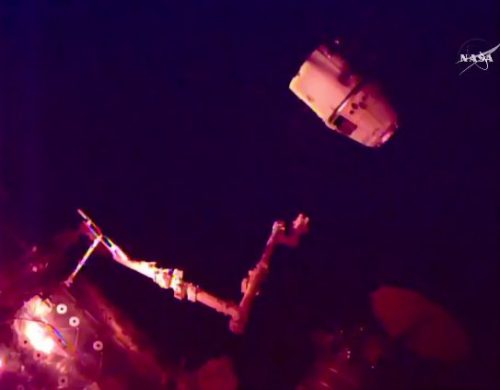
Within the first couple of minutes of release, as planned, Dragon executed a pair of separation maneuvers, with a third following at 9:32 a.m. EDT, allowing the spacecraft to pass outside the Keep-Out Sphere (KOS). The latter provides a collision avoidance zone for visiting vehicles and extends 650 feet (200 meters) around the ISS. “Departure Burn #3 is complete and Dragon is outside the Keep-Out Sphere,” Aunon radioed Peake at 9:34 a.m. Within five minutes of the completion of the third burn, Dragon departed the 0.8-mile-radius (1.4 km) Approach Ellipsoid (AE) and established itself onto a safe free-drift trajectory, where it could remain, if necessary, for up to 24 hours.
Once outside the AE, NASA’s involvement in the mission came to an end, and re-entry preparations were overseen by Mr. Tompkins’ team in Hawthorne. Over the next several hours, the cargo ship gradually opened up a gap of about 90 miles (150 km) from the space station. Its Guidance, Navigation & Control (GNC) Bay Door was closed to protect its delicate navigation sensors, and its Draco thrusters ignited at 2:01 p.m. EDT, burning for about 10 minutes and slowing it by about 330 feet (100 meters) per second to begin the plunge Earthward. Fifteen minutes later, the unpressurized trunk was discarded to burn up in the atmosphere, leaving the pressurized cargo module heading for a splashdown in the Eastern Pacific Ocean, about 261 miles (420 km) southwest of Long Beach, Calif.
“Dragon’s deorbit burn complete and trunk has been jettisoned,” SpaceX tweeted at 2:21 p.m. “Targeting Pacific splashdown with critical @NASA science in about 35 minutes.” Shortly thereafter, the returning cargo ship bore the full brunt of atmospheric re-entry, as temperatures of up to 1,600 Celsius (2,900 Fahrenheit) were imposed on its Phenolic Impregnated Carbon Ablator (PICA-X) heat shield.
At length, having reached an altitude of 8.5 miles (13.7 km), the two drogue parachutes were deployed to slow the craft’s descent. “Dragon’s drogue chutes have been deployed,” SpaceX tweeted at 2:48 p.m. This was followed, a minute or so later, by the deployment of the three main canopies at 1.8 miles (3 km). “Dragon’s main parachutes have been deployed,” SpaceX followed up at 2:49 p.m. “Splashdown in about 5 minutes.” Deployment of the main chutes served to guide the spacecraft to a smooth splashdown at 2:54 p.m. (11:54 a.m. PDT), at about 12 mph (20 km/h). “Good splashdown of Dragon confirmed,” it was reported, “carrying thousands of pounds of @NASA science and research cargo back from the @Space_Station.” Recovery vessels had already put to sea from Long Beach on Tuesday and now have a maximum of 25-26 hours to bring Dragon back to the dock, in order for time-critical samples to be removed from the spacecraft. According to SpaceX, recovery teams had reached Dragon by 3:33 p.m. EDT (12:33 p.m. PDT).
Unlike all other unpiloted cargo ships which travel to the ISS—Russia’s Progress, Japan’s H-II Transfer Vehicle (HTV), Orbital ATK’s Cygnus, and the European Space Agency’s now-retired Automated Transfer Vehicle (ATV)—the SpaceX Dragon is alone in that it can bring cargo safely through the searing heat of atmospheric re-entry and achieve an intact oceanic landing. Following the loss of SpaceX’s previous Dragon (CRS-7) during ascent, last 28 June, today’s departure therefore marks the first occasion in almost a full year that a cargo ship has brought a pressurized payload successfully back to Earth.
And that payload is a substantial one. According to NASA’s Dan Huot, up to 3,700 pounds (1,700 kg) of hardware is being returned from the ISS. This includes 53 pounds (24 kg) of computer resources, 377 pounds (171 kg) of crew supplies, 602 pounds (273 kg) of EVA equipment, 1,138 pounds (516 kg) of vehicle hardware, and 1,292 pounds (586 kg) of utilization. Specifically, the haul includes the remainder of the human research results from the recently-completed One-Year Mission of Scott Kelly and Mikhail Kornienko—including blood, urine, and saliva specimens—as well as samples from the Protein Crystal Growth (PCG)-4 investigation and the Microchannel Diffusion Experiment. Also homeward-bound is EMU #3011, the Extravehicular Mobility Unit worn by Italian astronaut Luca Parmitano on his life-threatening EVA-23 in July 2013 and, more recently, by Tim Kopra during U.S. EVA-35 on 15 January. On both occasions, water bubbles were reported in the helmet, causing the EVAs to be terminated earlier than planned.
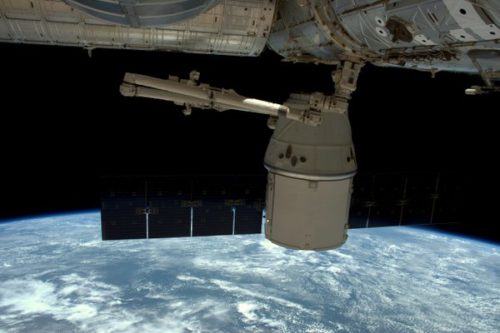
It has been a remarkable few months for SpaceX. Having lost CRS-7, the company rebounded and returned to flight operations before Christmas. The maiden voyage of its “Upgraded Falcon 9”—which benefits from “densified” cryogenic propellants, structural enhancements and a “full-thrust” suite of Merlin 1D+ engines—also saw the first successful landing of its first-stage hardware in an intact state on Landing Zone (LZ)-1 at Cape Canaveral Air Force Station, Fla. SpaceX then kicked-off 2016 in spectacular fashion: the swansong of the Falcon 9 v1.1 in January delivered NASA’s Jason-3 ocean altimetry spacecraft to orbit, whilst a trio of Upgraded Falcon 9s boosted the CRS-8 Dragon toward the ISS and the SES-9 and JCSAT-14 communications satellites to Geostationary Transfer Orbit (GTO).
Although the delivery of their primary payloads was the key indicator of mission success, one of the most visible aspects of the past few months has been SpaceX’s steadily maturing effort to land its Falcon 9 first stages on the deck of the Autonomous Spaceport Drone Ship (ASDS). Positioned about 410 miles (660 km) off the coast of Cape Canaveral, prior to each launch, the East Coast drone ship (nicknamed “Of Course I Still Love You”) has seen a mixture of success and failure. Four “close-but-no-cigar” landing attempts were made between January 2015 and March 2016, before a pair of triumphant, back-to-back successes on 8 April and 6 May. With nine Merlin 1D+ engines thus returned to the ASDS and LZ-1 on three missions in less than five months, SpaceX now has 27 of these powerplants—each capable of 1.5 million pounds (680,000 kg) of thrust—back in its inventory and ready for reflight as soon as summer 2016.
As highlighted by SpaceX, last week’s safe return of the first stage from the JCSAT-14 marked the first of its kind from a high-velocity and high-energy GTO-bound ascent. Not only did the landing attempt prove more restrictive upon propellant reserves for the Boost-Back, Supersonic Retro-Propulsion, and Landing engine “burns,” but it also produced “hotter” re-entry conditions than the CRS-8 first stage, which followed a more thermally benign trajectory to low-Earth orbit. Looking scorched and blackened, but in otherwise good condition, the Upgraded Falcon 9—which had alighted with almost pinpoint precision on the “X” of the drone ship’s deck—returned to Port of Cape Canaveral in the evening darkness of Monday, 9 May. Its four extendible landing legs were due to be removed today (Wednesday), as SpaceX engineers set to work on detailed inspections of the returned stage.
Meanwhile, CRS-8’s principal unpressurized payload—the Bigelow Expandable Activity Module (BEAM)—is now securely in place at the aft-facing port of the station’s Tranquility node. Current plans are for BEAM to be expanded from its “stowed” size of 5.7 feet (1.7 meters) long and 7.7 feet (2.4 meters) in diameter to its “deployed” size of 13 feet (4 meters) long and 10.5 feet (3.2 meters) in diameter on 26 May. The expansion procedure will be overseen by the Operations Support Officer (OSO) in Mission Control.
“No work has been done on the module since its installation,” NASA’s Mr. Huot told AmericaSpace on Tuesday. “Crew will do refresher training the week before deployment and in the days right before, conduct vestibule preparations and leak checks. Post-expansion, there will be six days of pressure checks, leak checks and vestibule checks before first ingress, currently targeted for 2 June.”
With the return of CRS-8, SpaceX’s next foray to the ISS is the CRS-9 mission, which Novosti Kosmonavtiki has hinted may launch as soon as 27 June. Following its arrival at the station, the Expedition 48 crew—Commander Jeff Williams and Russian cosmonauts Alexei Ovchinin and Oleg Skripochka, together with new arrivals Anatoli Ivanishin, Kate Rubins, and Takuya Onishi—will begin the effort to unload Dragon of its cargo. Inside the unpressurized trunk will be the second Boeing-built International Docking Adapter (IDA-2), which will provide an interface for the arrival of the CST-100 Starliner and Crew Dragon commercial vehicles from 2017 onward.
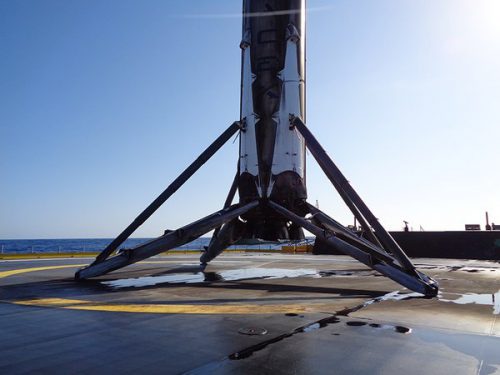
Originally, IDA-2 was expected to provide a backup Commercial Crew docking port, affixed to the space-facing (or “zenith”) interface of the Harmony node, at the tip of Pressurized Mating Adapter (PMA)-3. Its twin, IDA-1, would provide the primary port, at the forward “end” of Harmony, on PMA-2. However, IDA-1 was lost in the CRS-7 launch failure, abruptly retasking IDA-2 to become the new “primary” port. A replacement docking adapter for emplacement at the Harmony zenith backup location would be fabricated from “existing or residual spare parts from the original IDA development.” On 23 February 2016, NASA and Boeing signed a $9 million contract to build and test IDA-3 in the Space Station Processing Facility (SSPF) at the Kennedy Space Center (KSC) in Florida, with the expectation that it will be delivered for pre-flight processing in March 2017. Leveraging existing and residual spare parts, it was noted, would offer NASA “an affordable solution that made the best use of those assets.” A date and mission for launching IDA-3 has yet to be announced, although SpaceX’s CRS-14 mission—provisionally targeted to fly in the fourth quarter of 2017—has been suggested as a possibility.
As outlined previously by AmericaSpace, the effort to install the IDA onto Harmony’s forward port will be a synchronized robotics/EVA operation. The docking adapter will be removed from Dragon’s trunk by means of the 57.7-foot-long (17.6-meter) Canadarm2 robotic arm, controlled by the Robotics Officer (ROBO) in Mission Control. The EVA team—consisting of two members of Expedition 48’s U.S. Orbital Segment (USOS) crew of Williams, Rubins, and Onishi—would venture out of the Quest airlock, as ROBO manipulates IDA-2 to a position near Harmony’s forward port.
The spacewalkers will attach tether straps to IDA-2, whereupon it will be released by the ISS robotics and manually maneuvered into place. External connectors and internal switches and driven hook-motors will be closed to permit full integration. Other “get-ahead” tasks, though not fully defined at present, may include the installation of new High-Definition (HD) cameras to replace current external cameras. As far as timing is concerned, Mr. Huot told AmericaSpace that IDA-2 will not be extracted from the Dragon trunk until the final week of CRS-9’s stay at the ISS. Assuming an on-time launch, unberthing and departure of the cargo ship is targeted for around 1 August, placing the installation and EVA somewhere in the late-July timeframe.
Want to keep up-to-date with all things space? Be sure to “Like” AmericaSpace on Facebook and follow us on Twitter: @AmericaSpace





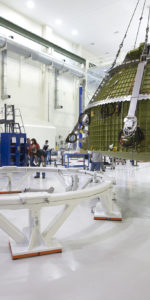
This had the rest of the kelly samples. Am curious what they learned on the first 11 month stay in LEO.
Then they should head over to Russia and ask the guys whose records from the 80’s and 90’s on Mir still stand. https://en.wikipedia.org/wiki/List_of_spaceflight_records#Ten_longest_human_space_flights
Didn’t know they each had a twin on the ground and carefully planned experiments to take advantage of it.
The Russian data from Mir were already analyzed by NASA they are part of the studies.
It’s good to see cargo/science samples being returned from ISS, again. NASA should get to the bottom of that water-in-the-suit issue. I wouldn’t want to see no one get drowned while in space.
Yep, that “water-in-the-suit issue” needs to be fixed.
And there might be some potential foreign competitors to SpaceX.
See: ‘Who Will Run the Chinese SpaceX? Space Race Capitalism Has Arrived in Beijing
Don’t be surprised if the world’s next big private space company rises in China.’
By Neel V. Patel May 17, 2016
At: https://www.inverse.com/article/15726-who-will-run-the-chinese-spacex-space-race-capitalism-has-arrived-in-beijing
I read over that article. It will be interesting how much leeway Chinese authorities give a ‘private launch enterprise.’
Arth –
“Driven by favorable economics and evolving technologies, the pace of change in the global space industry is due to increase even beyond recent developments.”
And, “The new imaging satellites and other small satellites, or smallsats, have created a large and growing demand for small, affordable launch vehicles. Over 20 new launch vehicles are being developed to serve this demand.” Quotes from: ‘Effects of changing economics on space architecture and engineering’ By Gary Oleson May 16, 2016 At: The Space Review
Growing market demands can have big influences everywhere. I’ve spent lots of time in China over the last 32 years and have seen more dramatic and positive changes in China than most folks would imagine.
China needs to make lots of high tech money because its low tech manufacturing is shifting to elsewhere.
Time will tell.
“And the International Science and Technology Center in Moscow and the Science and Technology Center in Ukraine have engaged with scientists and technicians that used to work on Category I programs to give those experts civil, non-missile work at home to lessen their potential economic incentive to go work for proliferation programs.”
From: ‘Strategy The Missile Technology Control Regime in U.S. Nonproliferation Strategy
Remarks By Vann Van Diepen Principal Deputy Assistant Secretary, Bureau of International Security and Nonproliferation’ Washington, DC July 30, 2012
At: http://www.state.gov/t/isn/rls/rm/198161.htm
Does this American Nonproliferation Strategy indicate that any and all the eventually unemployed “scientists and technicians” who worked for SpaceX and Gary Oleson’s above noted “Over 20 new launch vehicles are being developed” will also be given employment similarly to that was which given to “scientists and technicians that used to work on Category I programs to give those experts civil, non-missile work at home to lessen their potential economic incentive to go work for proliferation programs”?
Is anyone seriously thinking about the real hidden costs and national security risks of our President’s encouragement of the international proliferation of “cheap” low tech ICBM/launcher technology demonstrations?